Our Verdict
This is the most impressive CPU money can buy right now, but you have to have a very good reason to buy this over the excellent Core i5 13600K.
For
- Fastest in games
- Mighty multithreaded performance
- Super quick and responsive
- Cheaper 600-series platform available
Against
- Do you really need it?
- The Core i5 13600K is tough to beat for performance-per-dollar
- Power hungry
- Hot
- Slower than Alder Lake in some games
PC Gamer's got your back
Intel's Core i9 13900K is spectacularly good at what it does, and what it does is pretty much everything. Gaming? Of course, it can push high frame rates alongside the latest GPUs. Multitasking? Yep, easy. With 24 cores it's perfectly suited to lots of stuff happening all at once. High-demand creative workloads? Absolutely, it barely breaks a sweat.
Intel's hybrid architecture has really come into its own with the Core i9 13900K. Throw it at any problem, and it's likely going to solve it in record time.
Now for some PC builders, that's an easy buy. You want the fastest chip around, here it is. But I would suggest that most PC gamers with a moderate budget will want to look at the Intel Core i5 13600K instead.
Sure, it's not as fast or as threaded, but it delivers nearly as high frame rates in games and has plenty of multicore chops for content creation and streaming. All for nearly half the price.
But to say the Core i9 13900K is too expensive would be wrong. It's actually, surprisingly priced roughly the same as a Core i9 12900K, despite being much faster, offering eight more cores, and arriving on a now cheaper platform. They're both fairly equal when it comes to game performance—neither holds back a modern GPU.
However, for how well-provisioned the Core i9 13900K is across the board, it's a chip that can make some sense for a power user or busybody in need of a significant boost for their desktop PC.
Intel Core i9 13900K architecture
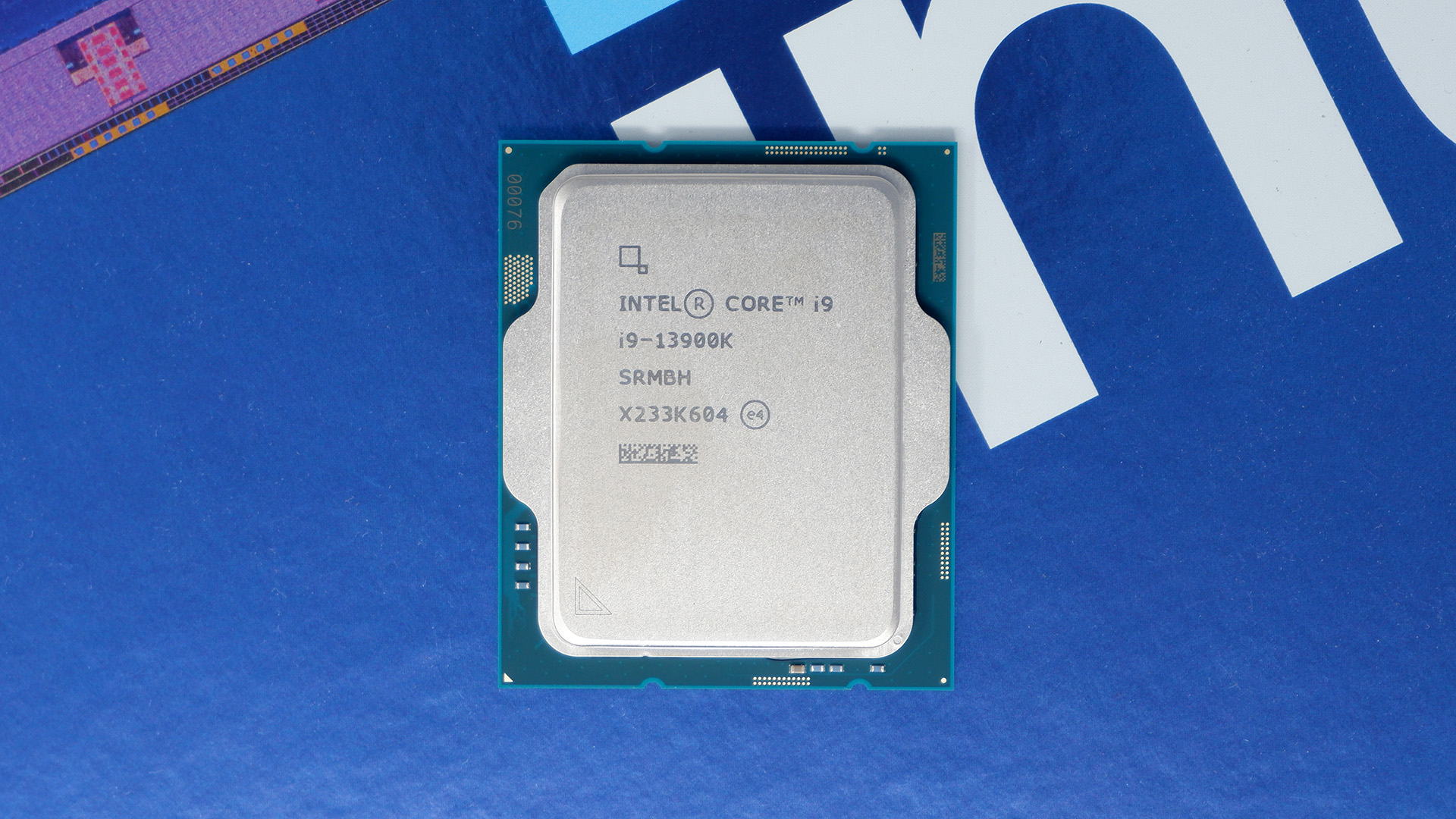
What is Raptor Lake?
The 12th Gen Alder Lake chips may have been Intel's first hybrid architecture, but the 13th Gen Raptor Lake processors are much more proof of what a hybrid approach is capable of. I have to say I'm a little surprised, in fact, as Raptor Lake is much more than the generational stop-gap before Meteor Lake that I was initially expecting.
Keep up to date with the most important stories and the best deals, as picked by the PC Gamer team.
At a fundamental level you'll find two types of cores in Raptor Lake: Performance-cores (P-cores) and Efficient-cores (E-cores).
The P-cores are more like the kind you'd expect to see in a gaming processor: big, fast, and great for pushing high frame rates. These you can expect to see hitting high 5GHz clock speeds pretty much across the board with Intel's 13th Gen K-series chips. You can also push these P-cores to a more impressive 6GHz under the right conditions.

The Raptor Cove core powers the P-core in Intel's 13th Gen, which replaces the Golden Cove core found in 12th Gen processors. The most notable improvement is the increase in L2 cache: from 1.25MB per P-core on Golden Cove to 2MB per core on Raptor Cove. That's a pretty massive uplift by desktop CPU standards, and will have a direct impact on performance as the P-cores have to call out to slower memory further away from the chip less often.
Intel has rolled out an improved process node for use with the 13th Gen. It's Intel 7 still, but it's a newly-optimised Intel 7 that Intel cites as 3rd gen Intel SuperFin. With this it claims "significantly better channel mobility" and, in Raptor Lake's case specifically, a focus on high speeds.
E-cores have a much smaller physical footprint on the chip. It makes for quite an interesting game of spot the difference between a hybrid and non-hybrid chip, and even between the Alder Lake and Raptor Lake dies. E-cores are suited best to the busywork your processor has to deal with while it's also stressing over frames in-game. Stuff like background tasks and taking care of those utilities and apps you want to leave on while you use your PC. E-cores run much slower than the P-cores, around 2–4GHz.

These E-cores are using the same Gracemont core design as Alder Lake, so you're largely relying on the higher counts of E-cores to push multithreaded performance up with Raptor Lake. Though further optimisations to Raptor Lake's Compute Fabric, caching policy, memory subsystem, and ring frequency to support the newly beefed up core counts will also make a difference, as will the new and improved P-cores.
The task of dividing up work between the P-cores and E-cores falls on your OS, but Intel has Thread Director to help out with that. This block makes more telemetry data available to the OS to better help in sharing the workload over all available cores, and alongside the latest major Windows 11 update, 22H2, helps share the load from background and foreground tasks.
That said, a lot of Raptor Lake is recognisable from Intel's 12th Gen chips, but what's great with this first wave of 13th Gen CPUs is that there's simply more of everything: more E-cores, higher clocks, larger caches, and better performance. The Core i9 13900K is the chip set to benefit the most from this upgrade, so let's get into the processor's specs.
Intel Core i9 13900K specifications
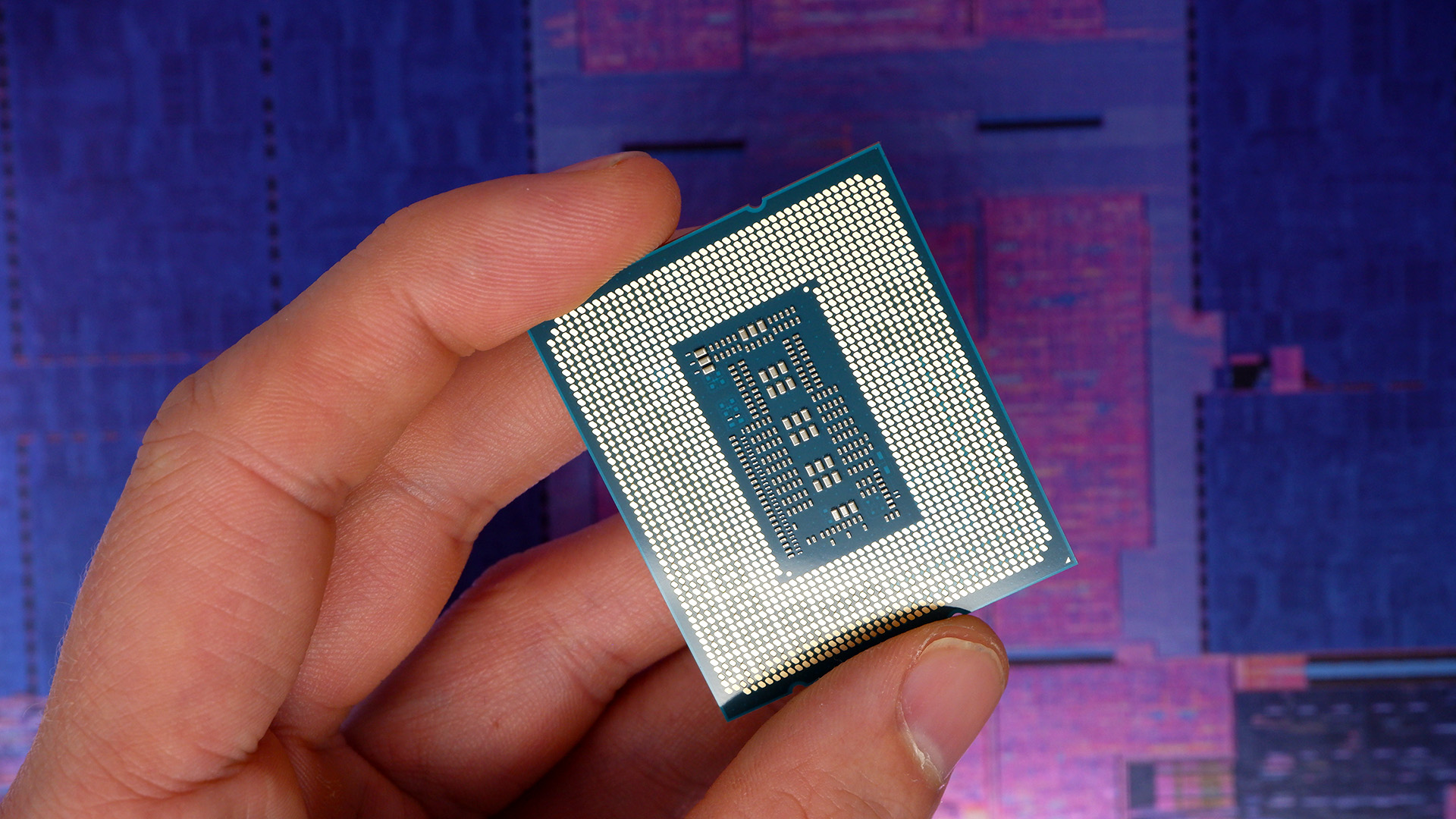
What's inside the Core i9 13900K?
Cores (P+E): 8+16
Threads: 32
L3 Cache (Smart Cache): 36MB
L2 Cache: 32MB
Max P-core Turbo frequency (GHz): 5.8
Max E-core Turbo frequency (GHz): 4.3
P-core base frequency (GHz): 3
E-core base frequency (GHz): 2.2
Unlocked: Yes
Max PCIe lanes: 20
Graphics: UHD Graphics 770
Memory support (up to): DDR5 5600MT/s, DDR4 3200MT/s
Processor Base Power (W): 125
Maximum Turbo Power (W): 253
RRP: $589–$599
'More is better' appears to be the mantra for Raptor Lake and the Core i9 13900K. The Core i9 13900K has been generously provisioned with a ton of E-cores, 16 in fact. That's double what you'll find on the Core i9 12900K, and those cores are not at all forgotten when it comes to the performance this processor offers in multithreaded tasks—these E-cores are as fast as they are many.
The E-cores hit a max Turbo of 4.3GHz, which won't be breaking any records, however, it is notably 400MHz quicker than the E-cores on the Core i9 12900K. Intel also now holds that its E-cores are as proficient as its Skylake cores but much more efficient. Similar claims were made with Alder Lake, but these E-cores are almost done dirty by Intel in sounding so much less important than the almighty Performance-cores. They're pretty darn quick and plenty proficient for plenty of tasks.
The P-cores are the focus for us gamers, however. The Core i9 13900K's P-core runs at 5.8GHz, which is so tantalisingly close to the 6GHz mark that you just wish it was possible out of the box. That's an accolade that the Core i9 13900KS will claim early next year, so if you're keen on that then you might have to wait a little longer for the special edition chip to arrive.
That 5.8GHz figure is the Thermal Velocity Boost frequency, which does require serious cooling to hit. You're more likely going to see 5.7GHz or below as you go about your gaming.
Still, these are incredibly quick cores, and both the P-cores and E-cores are backed up by 14MB of L2 cache and 30MB of L3.
When it comes to the platform for the 13th Gen, we're in luck. These chips use the same LGA 1700 socket size as the 12th Gen, and are fully compatible with 600-series motherboards. That should help bring the cost of these chips down, as when we first looked at the 12th Gen only the high-end Z690 motherboards were available and that made them much dearer as an upgrade. That's no longer the case, and we're actually testing the 13th Gen chips on an Asus Strix Z690 board and can confirm all runs well on the older, but nearly identical, chipset.
The only differences to note with the 700-series chipset is an increase of eight more PCIe 4.0 lanes and up to five USB 3.2 Gen 2 ports—though these specs will depend on whichever motherboard you decide to buy. In total, Intel's Core i9 13900K is able to deliver 16 PCIe 5.0 ports
What that also means is you're able to upgrade your Alder Lake chip to a Raptor Lake chip, though why you would after looking at the performance delta between these chips is another thing entirely.
Intel Core i9 13900K performance

How does the Core i9 13900K perform?
If you wanted more multithreaded performance on desktop, you got it. The Core i9 13900K actually makes ex-HEDT chips look slow by comparison. In fact, Intel's Core i9 13900K is almost 10,000 points clear of the Core i9 12900K in Cinebench R23. In the Blender Junk Shop benchmark, the Core i9 13900K is 60% faster than the Alder Lake chip.
If you want lots of speedy threads to throw at creative apps, this is it.
Similarly PCMark's score for general productivity is extremely high for the Core i9 13900K, and it delivers the highest memory bandwidth in SiSoft Sandra we've ever recorded. It also breaks through the 100fps ceiling in encoding benchmark x264, managing 109 fps and far in excess of the competition.
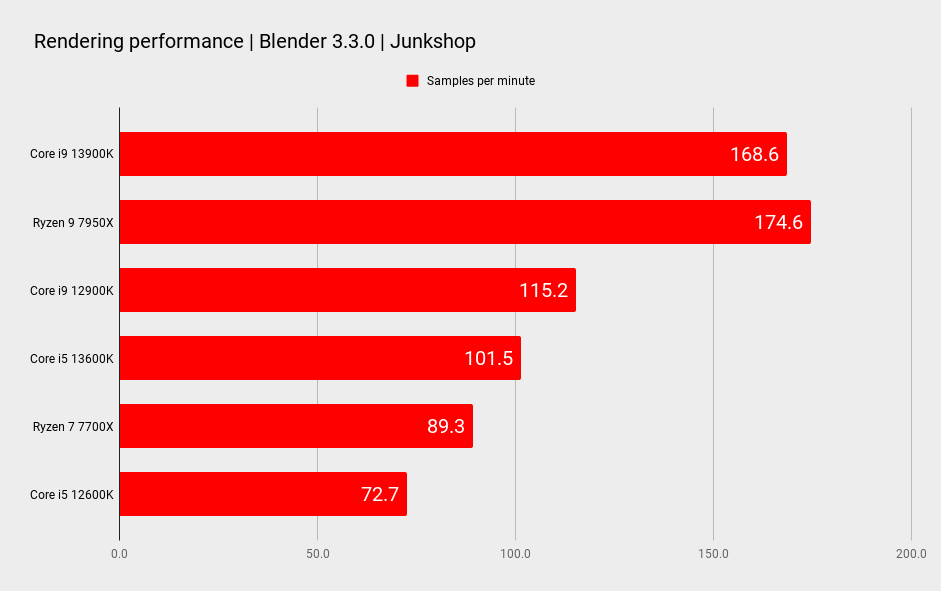

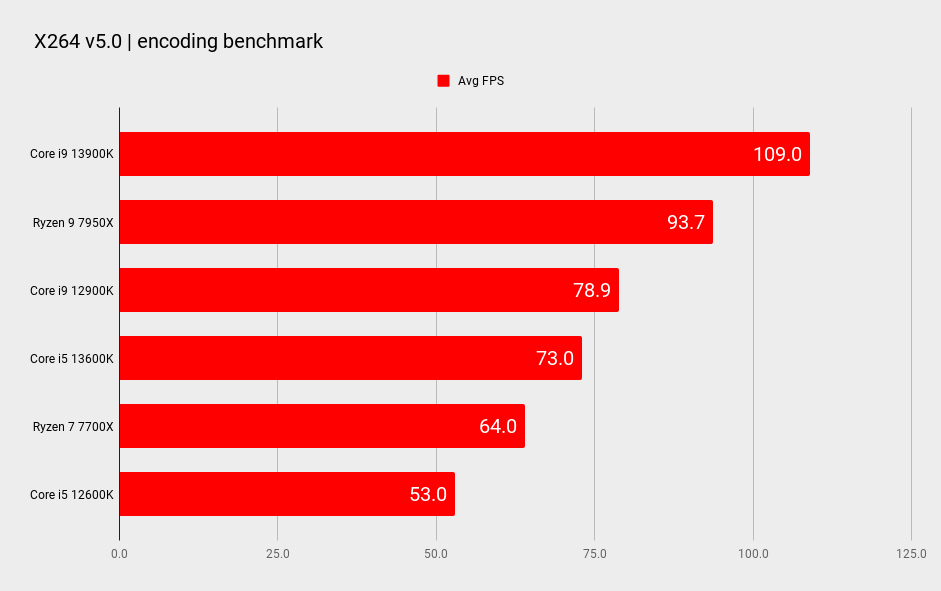
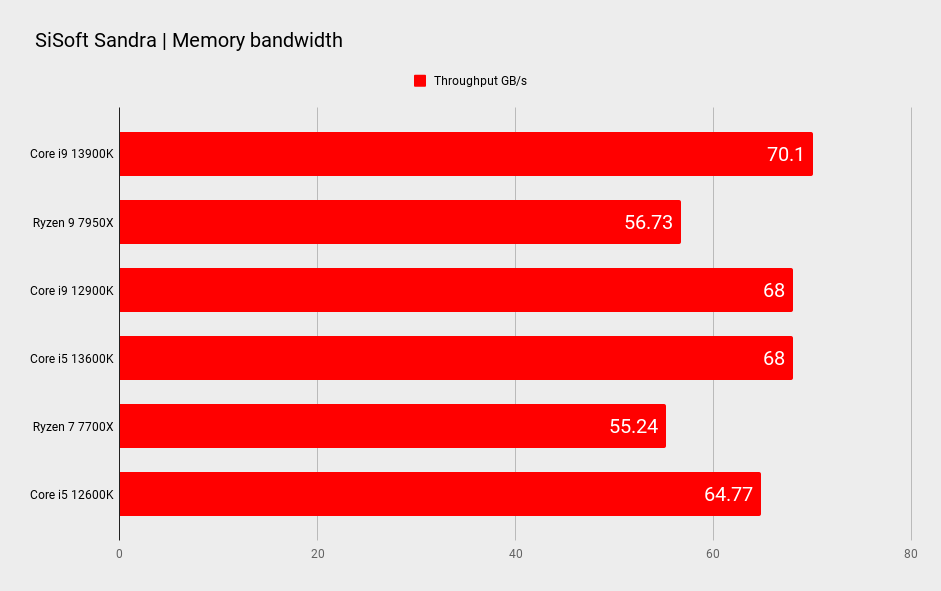
With these sorts of scores it's no wonder that high-end desktop (HEDT) CPUs are mostly a thing of the past—I'm surprised there's even a whiff of a HEDT Raptor Lake chip following the scores the Core i9 13900K is posting.
When it comes to gaming performance, the Core i9 13900K is equally impressive. This chip does little to hold back a modern high-end GPU, such as the RTX 3080 we're testing with, and I have no doubts it'll make the best pairing with Nvidia's new RTX 4090, too. Minimum and 1%/0.1% lows were also impressively high and consistently so, which is a good marker of CPU performance nowaday.
However, those extra cores don't mean much in gaming workloads. There were times when the Core i9 13900K struggled to show off what its clock speed and cache improvements are good for versus the previous generation's Core i9 12900K. Generally, I noticed only a moderate improvement in frames per second between the two generations' finest chips, and in two benchmarks performance actually dropped.


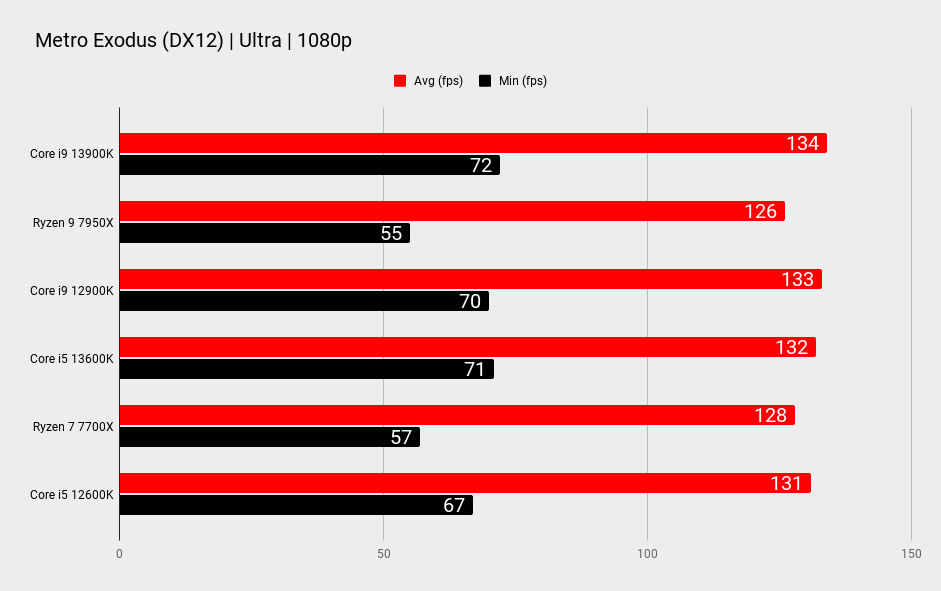
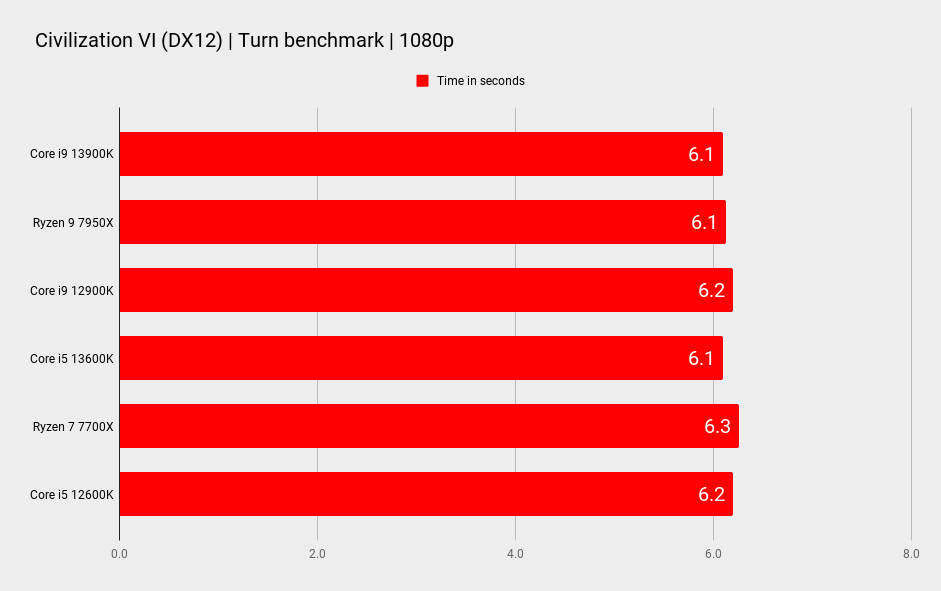

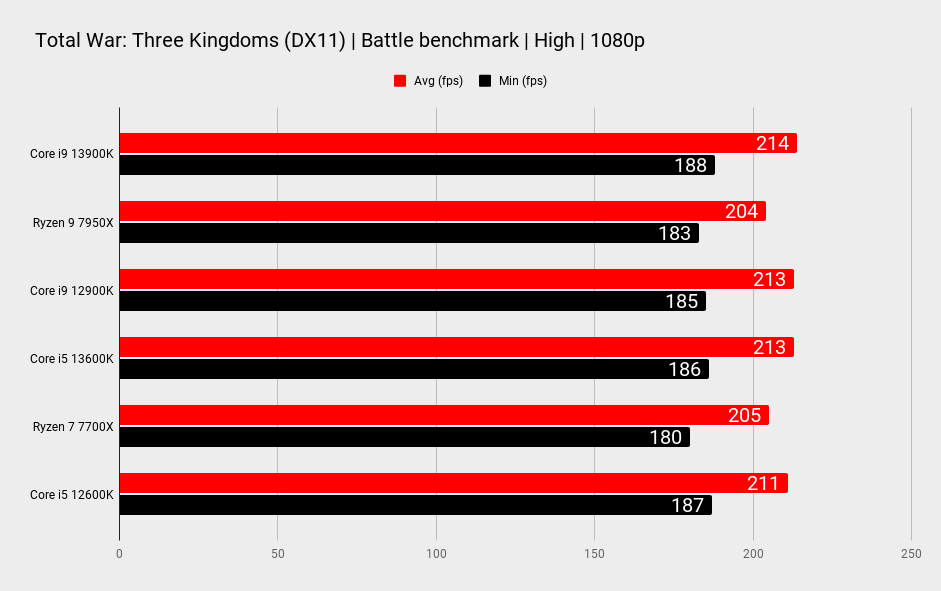
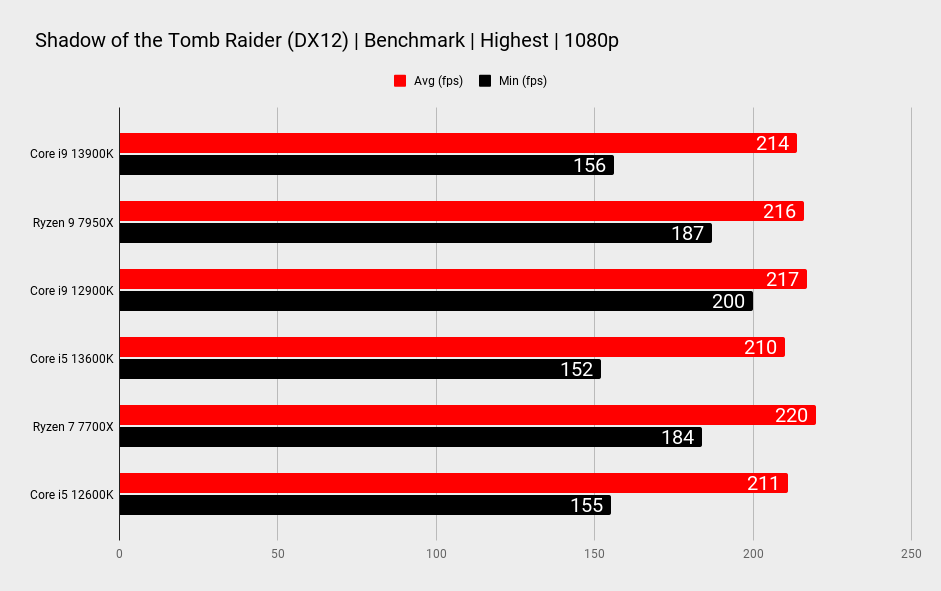
Intel
Motherboard: Asus ROG Strix Z690-F Gaming WiFi
Storage: 2TB Sabrent Rocket 4.0 Plus
Cooler: Asus ROG Ryujin II
PSU: Gigabyte Aorus P1200W
AMD
Motherboard: ASRock X670E Taichi
Storage: 1TB WD Black SN850
Cooler: Corsair H100i RGB
PSU: NZXT 850W
Shared
Memory: G.Skill Trident Z5 Neo DDR5-6000 CL30 2x 16GB
Graphics card: Nvidia RTX 3080 10GB
Both Shadow of the Tomb Raider and F1 2021 ran slower on the Core i9 13900K versus the Core i9 12900K, and the same can be said for the Core i5 13600K versus the Core i5 12600K. So perhaps there's some extra optimisation needing to be done in those games to extract more out of them. Intel's Marcus Kennedy told me that may be the required course of action following the publication of the company's own benchmarks that showed a couple of games running slower on Raptor Lake, but we'll have to wait and see.
In the games which are more CPU limited, namely Far Cry 6, and thus better able to show the performance disparity between chips, there remains only 4fps between the Core i9 13900K and Core i5 13600K. It's not a tremendous lead for a chip that's nearly double the price.
Generally, though, we're seeing top gaming performance with the Core i9 13900K (and Core i5 13600K, for that matter), which puts this chip at the top of the charts versus Intel's true rival, AMD.
Neither AMD's new Ryzen 9 7950X or Ryzen 7 7700X can match the gauntlet that Intel's Core i9 13900K is laying down in most games, with the sole exception of Shadow of the Tomb Raider. In Civ 6's AI test, the Core i9 13900K is neck and neck with AMD's Ryzen 9 7950X, but little over a second separates even the best CPUs from the worst in that benchmark nowadays.
In Total War: Three Kingdoms, the Core i9 13900K offers up 9fps more than the Ryzen 9 7950X. In Metro Exodus, 6fps. In F1 2021 and Far Cry 6, Intel's chip extends its lead by a larger margin, 13fps and 23fps, respectively.
Intel holds the gaming performance crown this generation. Though you really must consider that at 4K, these sorts of performance leads shrink to a much smaller margin, if any. Modern games are becoming far less CPU limited and far more GPU limited, and that means the GPU is only going to play more of an important role in game performance as time goes on. That's sure to be doubly true when DirectStorage rolls around, which will further free up the CPU while gaming.
If you're looking purely for a gaming chip, then, the Core i9 13900K is entirely overkill. You've got to look at its multithreaded performance and think 'that's something I could do with more of' to really consider spending this much on a chip. Or have plenty of money to spare and big bragging ambitions.
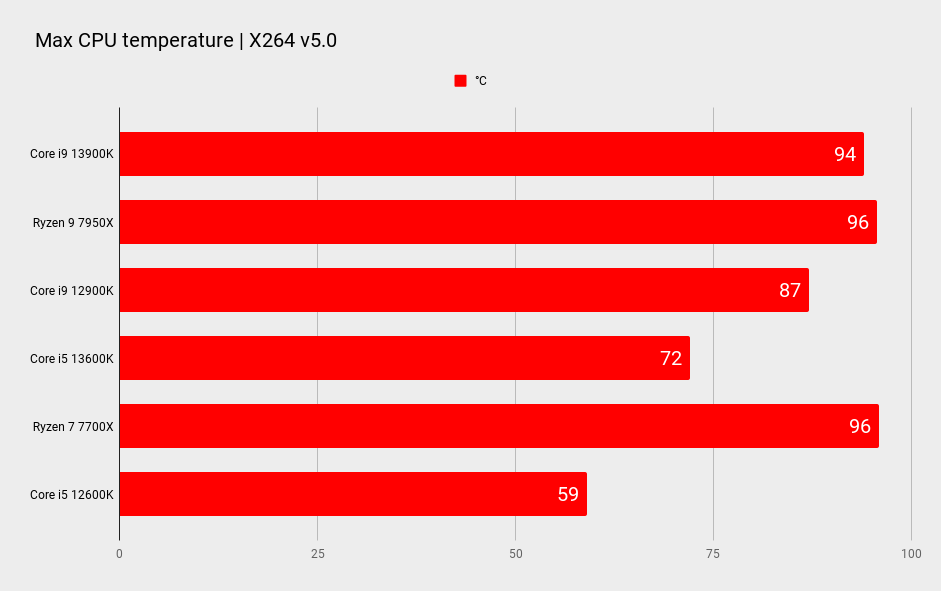
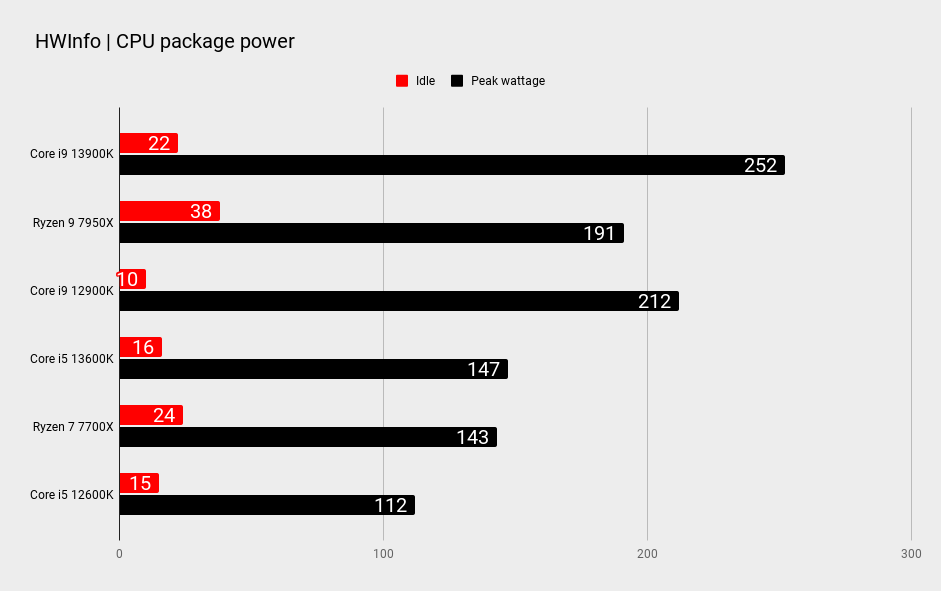
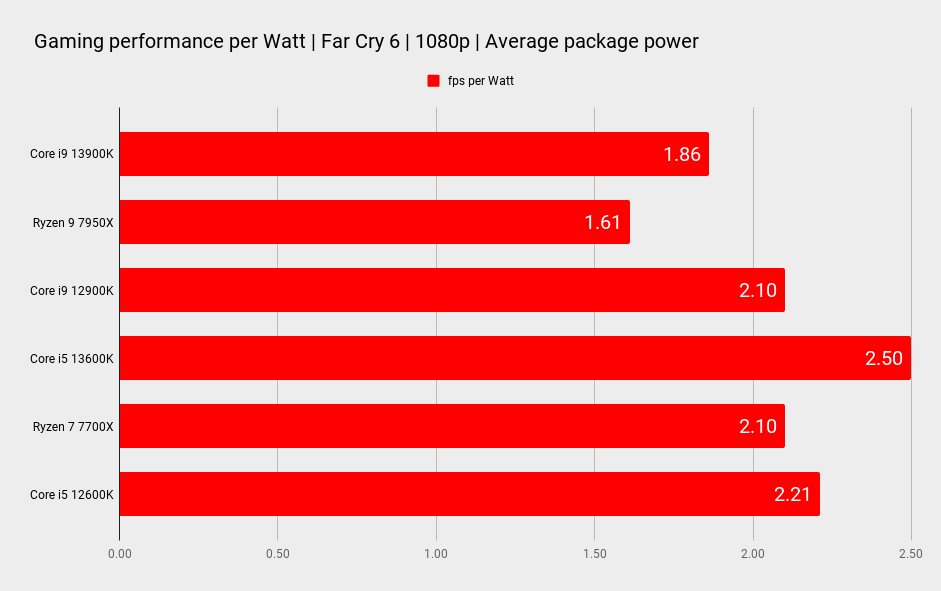
Turning to more creative endeavours, where once Intel's hybrid mix of cores couldn't quite live up to the might of a 16-core/32-thread Ryzen 9 7950X, and the Core i9 13900K is now a much more impressive match. In x264, the Core i9 13900K actually beats the Ryzen 9 7950X, which is rather impressive. It is also only six samples per minute slower in Blender's Junk Shop benchmark. The third-fastest chip in the Blender benchmark is the Ryzen 9 5950X, and that's down on the Core i9 13900K by 44.5 samples per minute. So it's close between the top two.
The only major loss for Intel here is in efficiency. The Core i9 13900K demands around 60W more under load in x264 than the Ryzen 9 7950X. That said, AMD's chip runs slightly hotter, and it tends to use up more power when idling. Similarly, the Core i9 13900K comes out looking more efficient in terms of fps per watt in Far Cry 6, but it's worth remembering this is the game that more heavily favoured Intel's processors in testing.
Intel Core i9 13900K analysis

How does the Core i9 13900K stack up?
Money is the real clincher here. As ever. At $589–599, the recommended customer pricing of the Core i9 13900K, and actually even if it's priced higher than that at launch, Intel's latest and greatest should cost less than AMD's $699 Ryzen 9 7950X.
If you run through the key battles for these two chips, you've got gaming performance, in which Intel's chip mostly wins out; productivity, multitasking, & creative performance, where the two are much closer and trade blows; and price, which Intel wins.
The few times that AMD's Ryzen 9 7950X does come out on top, the Core i9 13900K is often very close behind. Is that the sort of upper hand worth paying extra for? In my mind, no, it's not. Intel has done itself a huge favour by not massively increasing the asking price of its chips despite the increase in cores—a shot of adrenaline for its entire K-series lineup.
The Intel Core i9 13900K is more than enough processor to satisfy all gamers, streamers, and creative professionals.
I can see maybe some particularly demanding workloads for rendering or encoding in which 16 of Zen 4's finest will work better than Intel's 24 mix-and-match cores, but I've only seen that in Blender. Even then, the Ryzen hardly has a controlling lead. PCIe lanes may also be another important factor for some: AMD has the advantage in this department with 24 PCIe 5.0 lanes direct from the CPU.
But the reasons for buying AMD's top chip are becoming more niche than ever with the release of the Intel Core i9 13900K. And both are becoming niche as the mid-range CPUs enjoy ever-growing core counts. I wonder if we'll see the red team become more aggressive with its actual pricing on the shelf once the dust settles from Intel's release, because as it stands I fear its chips may be a tough sell next to Raptor Lake. Perhaps the $549 Ryzen 9 7900X will fare better, but then it's less likely to meet the requirements of the creative professional in need of all the cores quite like the Ryzen 9 7950X can.
The tougher sell for Intel is then to gamers that already have a fairly recent processor in their machine. You can probably write off most users with Alder Lake chips in their machines, there's very little reason to upgrade from a 12th Gen chip, but even 11th Gen and AMD's 5000-series processors still hold a candle to the 13th Gen for gaming.
Yeah, the Ryzen 7 5700X is slower at 1080p, but at 1440p, 4K? Is it fast enough to warrant ripping up my entire machine and starting again with a whole new build? Depends how old your current CPU is, I suppose.
But that's the never-ending cycle of CPU upgrades, and ultimately there will always be someone out there with a four-, five-, six-year-old processor looking for their next upgrade. If that's you, and you have the budget, or you're in truly desperate need of multithreaded performance, then I believe the Intel Core i9 13900K is more than enough processor to satisfy all gamers, streamers, and creative professionals.
Core i9 13900K verdict
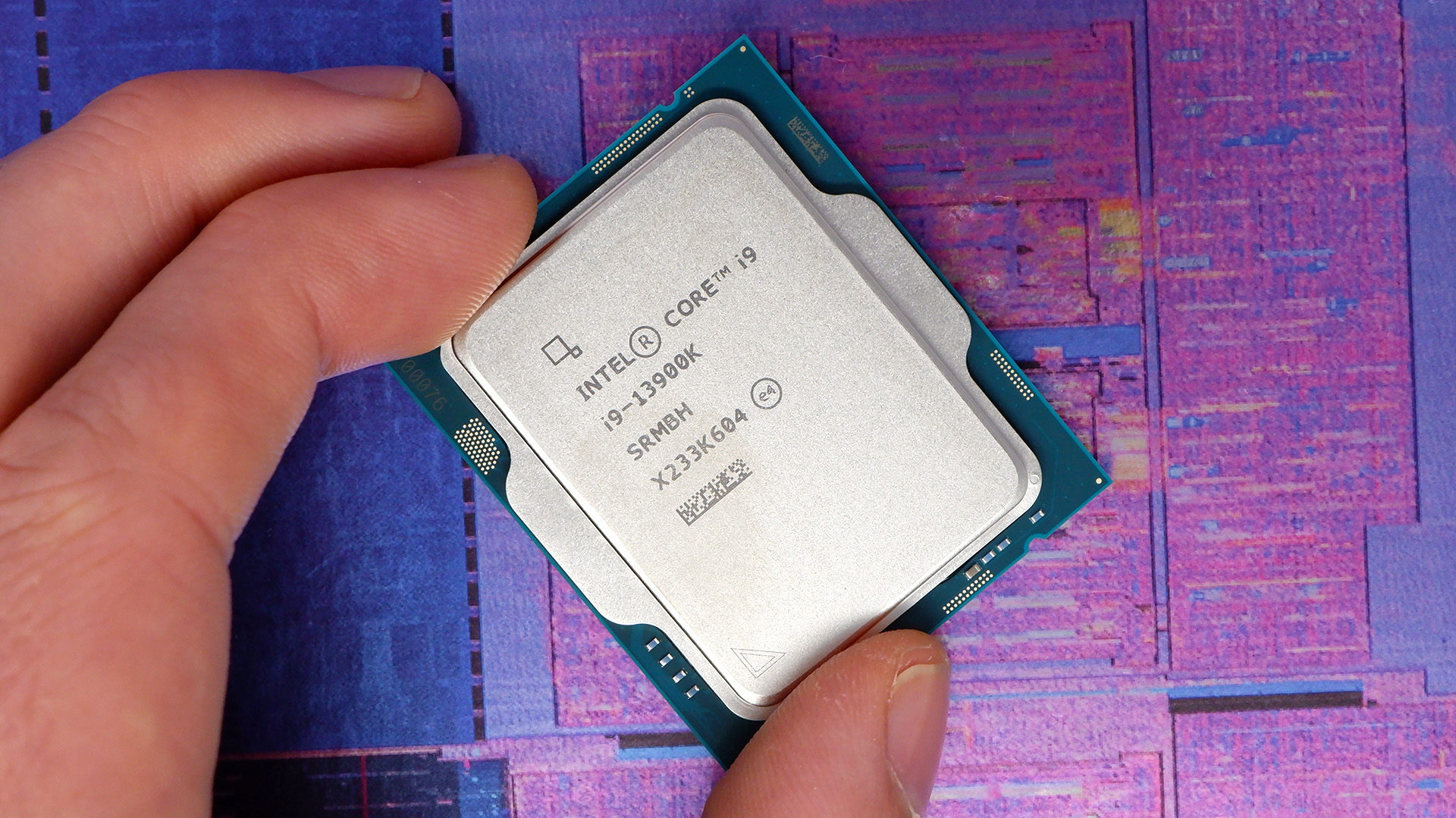
Should you buy the Core i9 13900K?
The Intel Core i9 13900K is a superb processor, and extremely good company for an enthusiast-grade graphics card. Its core count is extreme, even by today's standards, and its clock speed is pushing up to new heights only previously possible with a dousing of liquid nitrogen. It's incredibly impressive. Compare it to a Core i9 or Core i7 from just a few generations ago and you'd hardly believe it was the same company behind the Core i9 13900K.
Admittedly overkill for most.
Though admittedly also overkill for most. The average gamer isn't really going to benefit a whole lot from buying this Core i9 versus Intel's equally awesome, if not even more so, Core i5 13600K. I'm also dreaming up what might come later down the line in the Core i5 13400. That's at least one rightfully capable gaming chip at a fraction of the price of this multithreading leviathan.
But fine, I submit. I'm not going to belabour the point. This is a mighty processor at a surprisingly reasonable price, and a lot of builders will want one simply because it's the best of the best.
With Alder Lake and the 12th Gen, Intel proved its hybrid architecture was more than a flash in the pan concept. With Raptor Lake, it refined it into the best processor we've seen in a long time. I fully expect Raptor Lake and the Core i9 13900K to win back a lot of favour with PC builders—we're not at a loss for incredible processors right now and Intel's Core i9 13900K is top among them.
This is the most impressive CPU money can buy right now, but you have to have a very good reason to buy this over the excellent Core i5 13600K.

Jacob earned his first byline writing for his own tech blog, before graduating into breaking things professionally at PCGamesN. Now he's managing editor of the hardware team at PC Gamer, and you'll usually find him testing the latest components or building a gaming PC.

